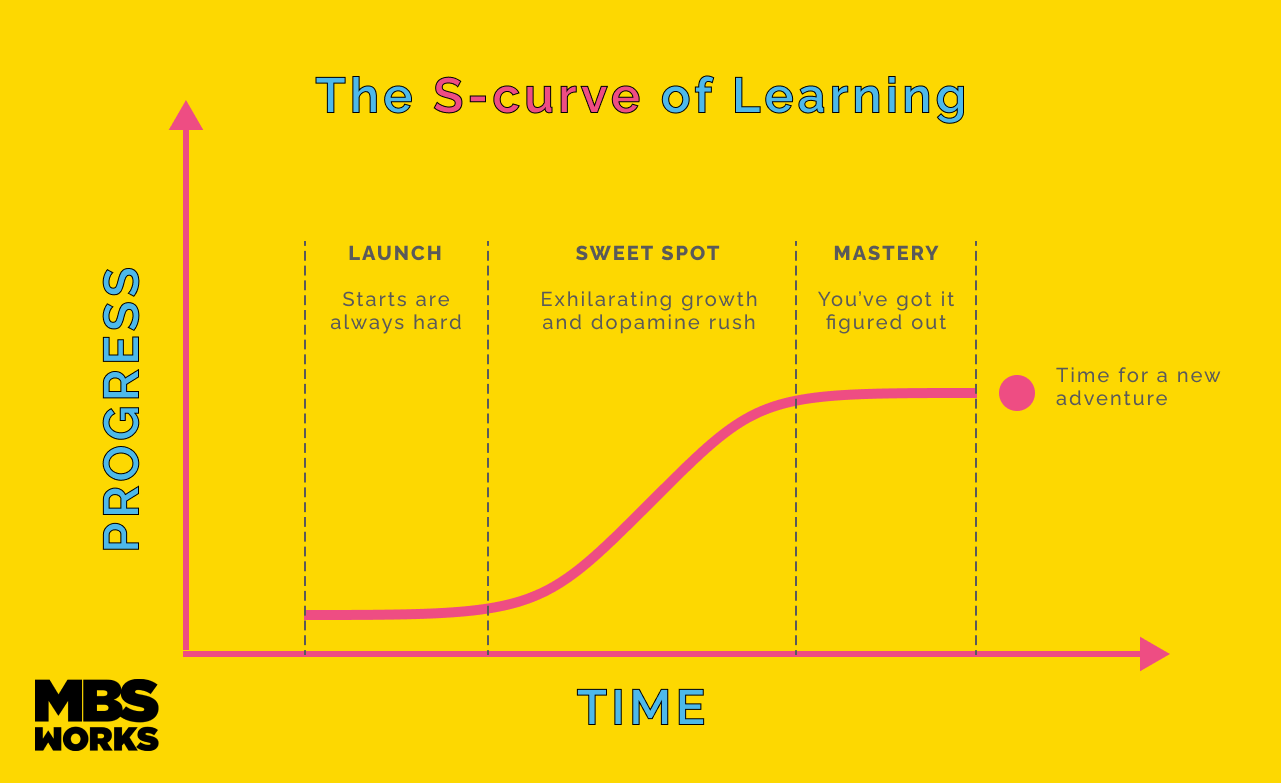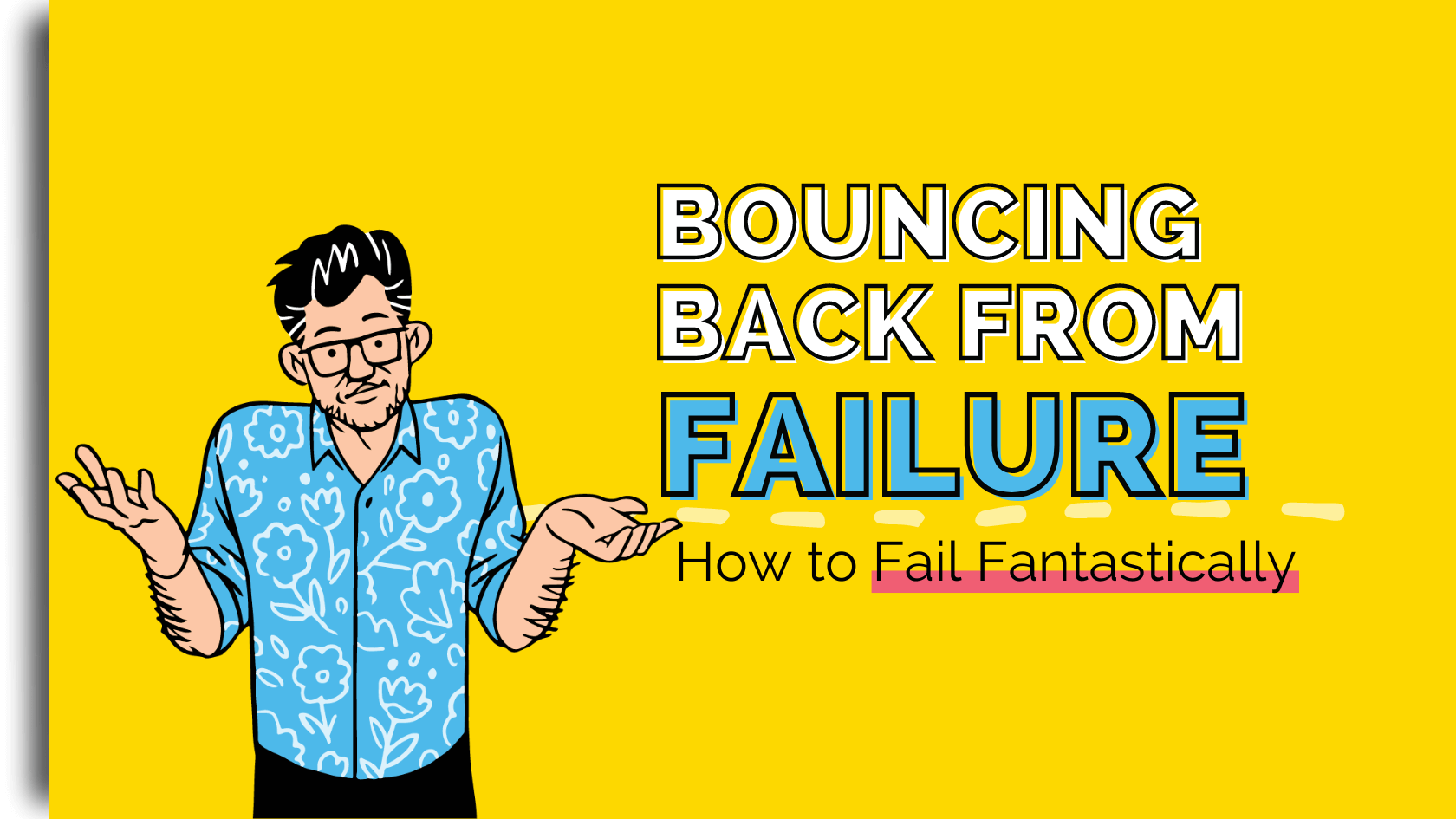Failure sucks. Failure is difficult. Failure hurts. Trust me, I get it.
But what if I told you that failure is also liberating, elevating… and fascinating?
Hear me out.
Very few people have ever succeeded on the first try.
I’m no exception. My book The Coaching Habit has sold over a million copies and is the best-selling coaching book of this century… but it took three years of rejected proposals to get there.
Every time I thought we were on the precipice of getting the book out the door, publishers would shut me down. It got to a point where I was REALLY close to giving up on this new book idea I had… and probably on the whole book-writing thing altogether.
But after every failure, and after a certain amount of time spent licking my wounds and feeling sorry for myself, I came back to take another shot at it. When the publisher said no a sixth time, I decided to self-publish. This changed everything, but I wouldn’t have gotten there without each successive failure that led to that point.
Pursuing any worthy goal means failing – sometimes a lot. But it’s how you encounter and navigate failure that truly sets you up for success.
Making Friends With Failure
Whenever I’m trying something new or feel like I’m failing, I like to frame it in the scale of conscious competence. It’s a model for understanding the four distinct psychological stages involved in learning a new skill.
It goes a little something like this:
- Unconsciously incompetent. Everyone starts here. It’s when you don’t even know that you suck at something. You have yet to discover it.
- Consciously incompetent. This is when you realize: “Oh, I should know this. I want to learn this.” So, you begin to learn. And you’re terrible. It’s a place of consistent micro failures but, more importantly, micro improvements.
- Consciously competent. You’re starting to feel confident in your capabilities at this stage. You still have to put the effort in, but you’ve got the hang of what you’ve set your mind to.
- Unconsciously competent. Finally, you enter the stage of mastery. The new skill is embedded deep in your bones. You’ve successfully stretched your comfort zone and, as a consequence, grown as a person.
And then… you move on to something new and start the whole brutal process all over again.
This is what’s known as the S curve – a cyclical visualization of the learner’s journey as they move from learning to mastery to learning to mastery and so on.
 You see, every time you reach the top of the S curve – unconscious competence – you plateau.
You see, every time you reach the top of the S curve – unconscious competence – you plateau.
Then boom, you’re back in your comfort zone.
At this point, it’s time to re-embrace failure and become a learner again. Otherwise, you risk becoming stuck in your own competence and missing out on all the opportunities out there for personal growth.
When we’re tested and broken open, we develop courage and insight and find our strengths.
9 Actionable Tips to Help You Reboot After Failure
When you pursue any worthy goal, you’ll experience bumps, dings, and failures along the way.
Stepping out to the edge is, after all, hard. It’s an act of discovery, not an easy slam dunk of crowd-roaring success. But the challenges help you unlock your potential, spark personal growth, and achieve your best.
Here’s how to hold space for the messiness that comes with creating something beautiful.
1. Reimagine Your Definition of Failure
The famous design company, IDEO, has a motto I like: fail faster to succeed sooner. It’s the idea that rapidly embracing failure is the fastest route to success.
I want you to shift your mindset around failure. Realize that stumbling as you embark on a new path is expected. If something doesn’t work or you need to start over, it’s a normal part of the process.
Instead of seeing failure as a burden or warning sign to quit, see it as a beckoning to take courage and improve. Starting again is a delightful gift – a chance to reimagine our work and ourselves for the better.
2. Find Failure Fascinating
Saying you embrace failure is much easier said than done – I get that. But an excellent way to physically and mentally reframe failure is through your posture.
In the book The Art of Possibility, Boston Philharmonic’s Ben and Rosalind Zander advocate students to exclaim “How fascinating!” as loud as they can while throwing their arms up whenever they make a mistake.
Why? Because failures are learning opportunities, and within the gesture is the understanding that this too will pass. More than that, the gesture shifts your body. It instantly changes your chemical composition, pivoting you towards curiosity and away from misery.
3. Embrace Enough, Shun Success
The ‘conditions of enoughness’ is an idea first taught to me by my friend Jen Louden, and it’s been revolutionary for how I approach success and failure.
Too often, success is thought of in black-and-white terms. You either make it, or you don’t. And when you do make it, there’s always another bar to reach. In the effort to chase the next triumph, it’s easy to lose control of your life.
When is enough, enough?
That’s exactly what Jen taught me to think about and what I’d now like you to consider.
Looking at what you’d like to achieve, what would be enough for you? Resist the urge to think in binary terms and look at the space between ‘failure’ and ‘success’ as a spectrum.
Often, that middle ground holds a generous space full of fulfillment and satisfaction.
4. Plan for Asteroids
Moving towards a worthy goal is like flying through the galaxy on a rocket ship. Even though you know where you’re headed, you’re going to be pulled off course by the gravitational force of planets, stars, and even passing asteroids.
Knowing that these setbacks will happen is crucial. Strategizing for failure, anticipating obstacles, and thinking about how you’ll get unstuck from roadblocks is what keeps you going when you inevitably encounter asteroids.
5. Incorporate After-Action Reviews
I greatly admire the U.S. military’s “after-action review” process. After every engagement, whether successful or unsuccessful, they pull the team together and ask each other some simple questions in a blame-free way.
They say: “What happened? What did we expect to happen? What did we learn from this? What do we need to do now? What do we need to do next time?”
Incorporating this discipline into your life is a really powerful way to generate more learning moments – both for yourself and the people around you. It helps you extract valuable data from a situation, so you can move forward with a little more knowledge every time.
6. Remember That This Too Shall Pass
“An Eastern monarch once charged his wise men to invent him a sentence, to be ever in view, and which should be true and appropriate in all times and situations. They told him, “And this, too, shall pass away.” How much it expresses! How chastening in the hour of pride! How consoling in the depths of affliction!”
– Abraham Lincoln
I love the phrase: “This, too, shall pass.” It’s a calling to look at the big picture. When things are going well, it reminds me not to get ahead of myself and remain humble. When times are tough, it helps me realize that they won’t be bad forever.
In fact, difficult times are a chance for growth. Keep that in mind and you can reframe the emotions around failure from exhausted and disheartened to nourished and fulfilled.
7. Quiet the Noise
Above, I mentioned how the U.S. military holds its reviews in a blame-free way. I recommend you do the same by channeling the principles of Nonviolent Communication.
Often, when we analyze a situation, our minds focus on a little bit of fact and a whole lot of opinions and judgments. These feelings often sound like the truth to us, but they’re not. In fact, the anxiety monsters in our heads can spin all sorts of lies that hurt our confidence and self-esteem.
Nonviolent communication techniques helps you untangle all the noise around those feelings to separate what’s true and accurate from your judgments and fears.
With that in mind, it’s a beneficial discipline to ask: “What are the facts?” “What’s the evidence?” after a setback. Doing this is a fantastic way to craft logical next steps toward your goal.
8. Get the Band Together
When journeying into uncharted territory, building a fantastic support system of family, friends, and mentors is more important than ever. After all, no man is an island (except for the Isle of Man).
But choosing the correct mix of support will help you reach your goals faster. I mean, you wouldn’t get a band together with four bass players and no drummer or vocalist.
In my book, How to Begin, I talk about the four archetypes that’ll help you as you work on your worthy goal. Each archetype brings a different energy. You’ll likely already have one or two of these energies within yourself but, for some, you’ll need to look to the people around you:
- The steady warrior who stands by you no matter what.
- The healer who encourages you when times are tough and helps you act as your best self.
- The teacher who provides guidance to help you overcome hurdles.
- The visionary who inspires you to unleash your potential and challenges you to leave your comfort zone.
If you want to strengthen your support network, I recommend joining our online community, The Conspiracy. It’s where people like you and me gather to work on worthy goals, share insights, and turn failures into learning moments.
9. Ponder the Prizes and Punishments
“Winning does not tempt him. His growth is: to be deeply defeated by ever greater things.”
– Rainer Maria Rilke
When you’re scared of taking a risk, or you’ve been knocked back by failure, you can regain your power by asking yourself: what are the prizes and punishments of me not doing this?
Every choice has prizes and punishments. The biggest reward, of course, is the comfort of safety. If you don’t try, you stay in control and can’t fail.
But the punishment of choosing the status quo means you won’t unlock your greatness. After all, without action, there can’t be any change. You’ll likely stay in a predictable plateau – comfortable for now, but sacrificing all the impact and fulfillment future you could create.
As the saying goes, what’s easy now will be hard tomorrow, and what’s hard now will be easy tomorrow. With that in mind, I’d now like you to think: what are the prizes and punishments of my committing to this?
This exercise allows you to articulate the benefits of being brave while acknowledging the possibility of failure. For the most part, it helps people realize they catastrophize the risks of trying something new and underestimate the internal nourishment of following their dreams.
Pursuing Your Dreams Is Hard, Exhilarating, and Important
Failure is never as finite as it first seems. When you embark on a worthy goal, you will feel scared and run into challenges.
But every challenge – every failure – is a gift. It’s a chance to stretch your courage, enrich your capabilities, think bigger, and move closer toward meaning.
If you found this helpful, I encourage you to check out my private online membership community, The Conspiracy. It’s where ambitious, kind humans like yourself make meaningful progress on big dreams—through structure, coaching, accountability, and a global network of support.

